- Home
- Shelby Foote
The Civil War: A Narrative: Volume 2: Fredericksburg to Meridian Page 32
The Civil War: A Narrative: Volume 2: Fredericksburg to Meridian Read online
Page 32
So far, despite the crowds of field hands who lined the banks to marvel at the appearance of ironclads where not even flat-bottomed packets had ventured before, Porter had not seen a single white man. He found this odd, and indeed somewhat foreboding. Presently, however, spotting one sitting in front of a cabin and smoking a pipe as if nothing unusual were going on around him, the admiral had the flagship stopped just short of another bridge and summoned the man to come down to the landing; which he did—a burly, rough-faced individual, in shirt sleeves and bareheaded; “half bulldog, half bloodhound,” Porter called him. When the admiral began to question him he identified himself as the plantation overseer. “I suppose you are Union, of course?” Porter said. “You all are so when it suits you.” “No, by God, I’m not, and never will be,” the man replied. “As to the others, I know nothing about them. Find out for yourself. I’m for Jeff Davis first, last, and all the time. Do you want any more of me?” he added; “for I am not a loquacious man at any time.” “No, I want nothing more with you,” Porter said. “But I am going to steam into that bridge of yours across the stream and knock it down. Is it strongly built?” “You may knock it down and be damned,” the overseer told him. “It don’t belong to me.” Catching something in his accent, Porter remarked: “You’re a Yankee by birth, are you not?” “Yes, damn it, I am,” the man admitted. “But that’s no reason I should like the institution. I cut it long ago.” And with this he turned on his heel and walked away. Porter had the skipper ring “Go ahead fast,” and the ironclad smashed through the bridge about as easily as if it had not been there. When he looked back, however, to see what impression this had made on the overseer, he saw him seated once more in front of the cabin, smoking his pipe, not having bothered even to turn his head and watch. Deciding that the fellow “was but one remove from a brute,” Porter was disturbed by the thought that “there were hundreds more like him” lurking somewhere in the brush. At any rate, he fervently hoped that Sherman’s men—particularly one regiment, which had the reputation of being able to “catch, scrape, and skin a hog without a soldier leaving the ranks”—would “pay the apostate Yankee a visit, if only to teach him good manners.”
Under the circumstances, even aside from the necessary halts, half a mile an hour was the best speed the ironclads could make on this St Patrick’s Day. Nightfall overtook them a scant eight miles from the morning’s starting point. Twelve miles they made next day, but the increased speed increased the damage to the boats, including the loss of all the skylights to falling debris, and when they stopped engines for the night, Porter heard from up ahead the least welcome of all sounds: the steady chuck of axes, informing him that the rebels were warned of his coming. He wished fervently for Sherman, whose men were still at work in Black Bayou, widening a pathway for their transports, and consoled himself with the thought that the red-haired general would be along eventually; “there was only one road, so he couldn’t have taken the wrong one.” For the present, however, he did what he could with what he had, sending the mortar boats forward in the darkness; and when their firing stopped, so had the axes. Next morning, March 19, he pushed on. Despite the delay involved in hoisting the felled trees aside, he made such good progress that by nightfall he was within half a mile of the entrance to Rolling Fork. At daybreak he steamed north again, but the flagship had gone barely two hundred yards when, just ahead and extending all the way across the creek, the admiral saw “a large green patch … like the green scum on ponds.” He shouted down from the bridge to one of the admiring field hands on the bank: “What is that?” “It’s nuffin but willers, sah,” the Negro replied, explaining that in the off season the plantation workers often went out in skiffs and canoes to cut the willow wands for weaving baskets. “You kin go through dat lak a eel.”
That this last was an overstatement—based on a failure to realize that, unlike skiffs and canoes, the gunboats moved through rather than over the water, and what was more had paddle wheels and overlapping plates of armor—Porter discovered within a couple of minutes of giving the order to go ahead. Starting with a full head of steam, the ironclad made about thirty yards before coming to a dead stop, gripped tightly by the willow withes, not unlike Gulliver when he woke to find himself in Lilliputian bonds. The admiral called for hard astern; but that was no good either; the vessel would not budge. Here was a ticklish situation. The high creekbanks rendered the warships practically helpless, for their guns would not clear them even at extreme elevation. Not knowing what he would do if the Confederates made a determined boarding attack, Porter fortified a nearby Indian mound with four smoothbore howitzers and put the flagship’s crew over the side with knives and hooks and orders to cut her loose, twig by twig. It was slow work; “I wished ironclads were in Jericho,” he later declared. Just then his wish seemed about to be fulfilled. The shrill shrieks of two rifle shots, which he recognized as high-velocity Whitworths, were followed at once by a pair of bursts, abrupt as blue-sky thunder and directly over the mound. Suddenly, in the wake of these two ranging shots—within six hundred yards of Rolling Fork and less than ten miles from clear sailing down the broad and unobstructed Sunflower River—two six-gun rebel batteries were firing on the outranged smoothbores from opposite directions, and the naval commander was shocked to see his cannoneers come tumbling down the rearward slope of the mound, seeking cover from the rain of shells. Continuing to hack at the clinging willows, he got his mortars into counterbattery action and, with the help of half a dollar, persuaded a “truthful contraband” (so Porter termed him later, but just then he called him Sambo; which drew the reply, “My name aint Sambo, sah. My name’s Tub”) to attempt to get a message through to Sherman and his soldiers, wherever downstream they might be by now. “Dear Sherman,” the note began: “Hurry up, for Heaven’s sake.”
Tub reached Sherman on Black Bayou late that night, having taken various short cuts, and Sherman started northward before daylight, accompanied by all the troops on hand. Retracing the messenger’s route through darkness, they carried lighted candles in their hands as they slogged waist-deep through swamps and canebrakes. “The smaller drummer boys had to carry their drums on their heads,” the general afterwards recalled, “and most of the men slung their cartridge boxes around their necks.” All the following day they pushed on, frequently losing their way, and into darkness again. At dawn Sunday, March 22, they heard from surprisingly close at hand the boom of Porter’s mortars, punctuated by the sharper crack of the Whitworths. Presently they encountered rebels who had got below the ironclads and were felling trees to block their escape downstream. Sherman chased them from their work and pushed on. Soon he came within sight of the beleaguered flotilla, but found it woefully changed in appearance. After finally managing to extricate the willow-bound flagship with winches, Porter had unshipped the rudders of all five gunboats and was steaming backward down the narrow creek, fighting as he went. He had not only heard the sound of axes in his rear; what was worse, he had suddenly realized that the Confederates might dam the creek upstream with cotton bales and leave him stranded in the mud. The arriving bluecoats ran the snipers off—they were not actually so numerous as they seemed; just industrious—and came up to find the admiral on the deck of the flagship, directing the retreat from behind a shield improvised from a section of smokestack. “I doubt if he was ever more glad to meet a friend than he was to see me,” Sherman later declared. For the present, though, he asked if Porter wanted him to go ahead and “clean those fellows out” so the navy could resume its former course. “Thank you, no,” the admiral said. He had had enough, and so had Sherman, who complained hotly that this was “the most infernal expedition I was ever on.” As Porter subsequently put it, “The game was up, and we bumped on homeward.”
All the way downstream, from Deer Creek through Black Bayou, the sailors took a ribbing from the soldiers who stood along the banks to watch them go by, in reverse and rudderless. “Halloo, Jack,” they would call. “How do you like playing mud turtle?” �
��Where’s all your masts and sails, Jack?” “By the Widow Perkins, if Johnny Reb hasn’t taken their rudders away and set them adrift!” But an old forecastleman gave as good as he got. “Dry up!” he shouted back at them. “We wa’n’t half as much used up as you was at Chickasaw Bayou.” So it went until the gunboats regained Steele Bayou and finally the mouth of the Yazoo, where they dropped anchor—those that still had them—and were laid up for repairs. Within another week they were supplied with new chimneys and skylights and woodwork; they glistened with fresh coats of paint, and according to Porter, “no one would have supposed we had ever been away from a dock-yard.” By then, too, the officers had begun to discuss their share in this sixth of Grant’s Vicksburg failures with something resembling nostalgia. There was an edge of pride in their voices as they spoke of the exploit, and some even talked of being willing to go again. But they did so, the admiral added, much “as people who have gone in search of the North Pole, and have fared dreadfully, wish to try it once more.”
• • •
Despite the high hopes generated during the preliminary reconnaissance up Steele Bayou, Grant was no more discouraged by this penultimate failure, reported in no uncertain terms by a disgusted Sherman, than he had been by the preceding five. Now as before, he already had a successive experiment in progress, which served to distract the public’s attention and occupy his mind and men. Besides, for once, he had good news to send along to Washington with the bad—the announcement of the first real success achieved by Federal arms on the river since his arrival in late January—although his pleasure in reporting it was considerably diminished by the fact that it had been accomplished not in his own department but in Banks’s, not by the army but by the navy, and not by Porter but by Farragut.
Banks himself had been having troubles that rivaled Grant’s, if not in number—being limited by a lack of corresponding ingenuity and equipment in his attempts to come to grips with the problem—then at any rate in thorniness. Port Hudson was quite as invulnerable to a frontal assault as Vicksburg, so that here too the solution was restricted to two methods: either to attack the hundred-foot bluff from the rear or else to go around it. He worked hard for a time at the latter, seeking a route up the Atchafalaya, into the Red, and thence into the Mississippi, fifty miles above the Confederate bastion. At first this appeared to be ready-made for his use, but it turned out to be impractical on three counts, 1) He had only one gunboat designed for work on the rivers; 2) a large portion of the Atchafalaya basin was under water as a result of breaks in the neglected levees; and 3) he became convinced that to leave the rebel garrison alive and kicking in his rear would be to risk, if not invite, the recapture of New Orleans. This last was so unthinkable that it no sooner occurred to him than he abandoned all notion of such an attempt. As for attacking Port Hudson from the rear, he perceived that this would be about as risky as attacking it from the front. Knowing nothing of Grant’s success or failure upriver, except the significant fact that something must have happened to delay him, Banks did not know but what the Confederates would be free to concentrate against him from all directions, including the north, as soon as he got his troops ashore; which would mean, at best, that he would lose his siege train in a retreat from superior numbers, and at worst that he would lose his army. Thus both methods of approaching a solution to the problem seemed to him likely to end in disaster; he did not know what to do, at least until he could get in touch with Grant upstream. Consequently, he did nothing.
This reverse approach, with its stress on what the enemy might do to him, rather than on what he intended to do to the enemy, had not been Grant’s way of coming to grips with the similar problem, some three hundred miles upstream; nor was it Farragut’s. The old sea dog—approaching sixty-two, he was Tennessee-born and twice married, both times to Virginians, which had caused some doubt as to his loyalty in the early months of the war—had surmounted what had seemed to be longer odds below New Orleans the year before, and he was altogether willing to try it again, “army or no army.” In early March, when he received word that the rebels, by way of reinforcing their claim to control of the whole Red River system, along with so much of the Mississippi as ran between Vicksburg and Port Hudson, had captured the steam ram Queen of the West, he took the action as a challenge to personal combat; especially when they emphasized it by sinking and seizing the ironclad Indianola, which for all he knew was about to join the Queen in defying the flag she once had flown. He promptly assembled his seven wooden ships off Profit’s Island, seven miles below Port Hudson, intending to take them past the fortified heights for a showdown with the renegade boats upriver. He had with him the three heavy sloops-of-war Hartford, Richmond, and Monongahela, the old side-wheeler Mississippi, and three gunboats. All were ocean-going vessels, unarmored but mounting a total of 95 guns, mostly heavy—the flagship Hartford alone carried two dozen 9-inch Dahlgrens—with which to oppose the 21 pieces manned by the Confederates ashore. This advantage in the weight of metal would be offset considerably, however, by the plunging fire of the guns on the hundred-foot bluff and by the five-knot current, which would hold the ships to a crawl as they rounded the sharp bend at its foot. In an attempt to increase the speed and power of his slower and larger ships, Farragut gave instructions for the three gunboats to be lashed to the unengaged port sides of the three sloops; the Mississippi, whose paddle boxes would not allow this, would have to take her chances unassisted. It was the admiral’s hope that the flotilla would steam past undetected in the moonless darkness, but a greenhorn chaplain, watching the gun crews place within easy reach “little square, shallow, wooden boxes filled with sawdust, like the spittoons one used to see in country barrooms,” was shocked to learn that the contents were to be scattered about the deck as “an absorbent” to keep the men from slipping in their own blood, when and if the guns began to roar and hits were scored. At 9.30 p.m. March 14, the prearranged signal—two red lights described by the same impressionable chaplain as “two distinct red spots like burning coals”—appeared just under the stern of the flagship in the lead, and the run began.
At first it went as had been planned and hoped for. Undetected, unsuspected, the Hartford led the way up the long straight stretch of river leading due north into the bend that would swing the column west-southwest; she even cleared the first battery south of town, her engines throbbing in the darkness, her pilot hugging the east bank to avoid the mudflat shallows of the point across the way. Then suddenly the night was bright with rockets and the glare of pitch-pine bonfires ignited by west-bank sentinels, who thus not only alerted the gun crews on the bluff, but also did them the service of illuminating their targets on the river down below. The fight began as it were in mid-crescendo. Still holding so close to the east bank that the men on her deck could hear the shouts of the enemy cannoneers, the flagship opened a rolling fire which was taken up in turn by the ships astern. The night was misty and windless; smoke settled thick on the water, leaving the helmsmen groping blindly and the gunners with nothing to aim at but the overhead muzzle flashes. In this respect the Hartford had the advantage, steaming ahead of her own smoke, but even she had her troubles, being caught by the swift current and swept against the enemy bank as she turned into the bend. Helped by her gunboat tug, she backed off and swung clear, chugging upstream at barely three knots, much damaged about her top and spars, but with only three men hit. Attempting to follow, the Richmond was struck by a plunging shot that crashed into her engine room and caromed about, cracking both port and starboard safety valves and dropping her boiler pressure below ten pounds. Too weak to make headway, even with the assistance of the gunboat lashed to her flank, she went with the current and out of the fight, leaking steam from all her ports, followed presently by the Monongahela, which suffered the same fate when her escort’s rudder was wedged by an unlucky shot, one of her own engines was disabled by an overheated crankpin, and her captain was incapacitated by a shell that cut the bridge from under him and pitched him headlong on
to the deck below. Between them, the two sloops and their escorts lost 45 killed and wounded before they veered out of range downriver. But the veteran frigate Mississippi—Commodore Matthew Perry’s flagship, ten years ago, when he steamed into Tokyo Bay and opened Japan to the Western world—took the worst beating of the lot, not only from the Confederates on the bluff, but also from the gunners on the Richmond, who, not having gotten the word that the sloop had turned in the opposite direction, fired at the flashes of the side-wheeler’s guns as they swept past her. Blind in the smoke, pounded alike by friend and foe, the pilot went into the bend and put the ship hard to larboard all too soon: with the result that she ran full tilt onto the mudflats across the way from the fuming bluff. Silhouetted against the glare of bonfires and taking hit after hit from the rebel guns, she tried for half an hour to pull loose by reversing her engines, but to no avail. Her captain ordered her set afire as soon as the crew—64 of whom were casualties by now—could be taken off in boats, and it was only through the efforts of her executive, Lieutenant George Dewey, that many of her wounded were not roasted, including a badly frightened ship’s boy he found hiding under a pile of corpses. Burning furiously, the Mississippi lightened before dawn and drifted off the flats of her own accord, threatening to set the other repulsed vessels afire as she passed unmanned among them and piled up at last on the head of Profit’s Island, where she exploded with what an observer called “the grandest display of fireworks I ever witnessed, and the costliest.”

 Chickamauga and Other Civil War Stories
Chickamauga and Other Civil War Stories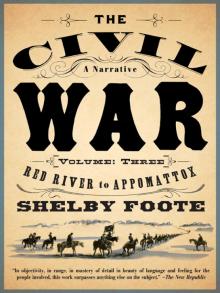 The Civil War: A Narrative: Volume 3: Red River to Appomattox
The Civil War: A Narrative: Volume 3: Red River to Appomattox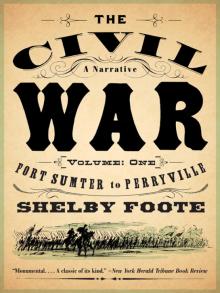 The Civil War: A Narrative: Volume 1: Fort Sumter to Perryville
The Civil War: A Narrative: Volume 1: Fort Sumter to Perryville Jordan County
Jordan County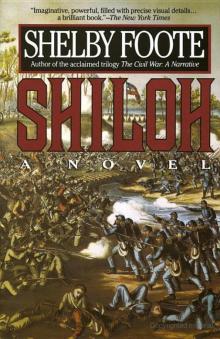 Shiloh
Shiloh Love in a Dry Season
Love in a Dry Season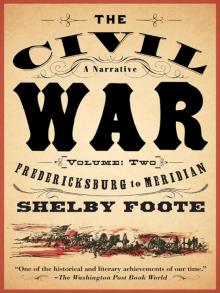 The Civil War: A Narrative: Volume 2: Fredericksburg to Meridian
The Civil War: A Narrative: Volume 2: Fredericksburg to Meridian Chickamauga
Chickamauga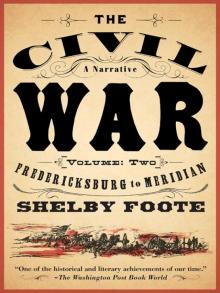 The Civil War: A Narrative: Fredericksburg to Meridian
The Civil War: A Narrative: Fredericksburg to Meridian